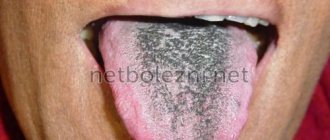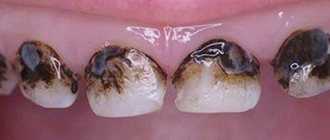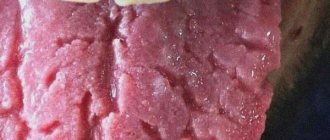The state of the tongue reflects the state of the human body. That is why almost any doctor during an examination asks the patient to show his tongue. In a healthy person, the tongue has a pale pink color, pronounced papillae, and a straight fold exactly in the center. It should be soft to the touch, and moving it should not cause discomfort or pain. If you find that you have a white tongue, then there is a high probability of certain problems in the body. In this article we will talk about how dangerous the appearance of plaque on the tongue is, what causes and diseases lead to changes in the condition of the organ, and how this problem can be avoided and eliminated.
Anatomy: what does the tongue consist of?
The tongue is an organ that is part of the digestive system. It performs several functions:
- plays an important role in the formation of speech;
- helps form a bolus of food in the mouth and push it into the esophagus;
- helps us determine the taste of food.
What does language consist of? The organ is conventionally divided into two parts:
- the body of the tongue is the anterior movable part;
- The root of the tongue is the back part located closer to the larynx.
The tongue has a mucous surface on which taste buds are located, thanks to which we distinguish different tastes.
Diagnostics
Before a full examination is scheduled, the doctor examines the oral cavity using special medical instruments - a spatula. By the way the greenish coating looks and the enlarged taste buds of the tongue, by the relief surface of the muscular organ, as well as by the thickness of the accumulations and their location, it is not difficult for an experienced doctor to understand the causes of the unpleasant phenomenon. In addition, doctors often prescribe general tests, ultrasound and FGDS.
Adults should initially consult a therapist; children should be shown to a pediatrician. If necessary, patients are referred to the following specialists:
- Gastroenterologist;
- Dentist;
- Infectious disease specialist;
- Otolaryngologist;
- Pulmonologist;
- Endocrinologist;
- Toxicologist;
Such manipulation as removing plaque is very important. This prevents the development of pathogenic microflora and ensures healthy oral mucosa. By the way, clean crowns prevent the appearance of caries - another provoking factor for the appearance of accumulations on the tongue.
What does plaque on the tongue mean?
At different periods of time, the appearance of the tongue may change, and a coating on the tongue that has a whitish color is acceptable in a small amount. At the same time, the papillae are clearly visible through it. In summer, the thickness of the plaque may increase, and in winter it may acquire a yellowish tint.
When should you worry about tongue coating?
- if the tongue is constantly coated;
- the plaque becomes dense and completely hides the mucous membrane;
- the papillae of the tongue are poorly visible;
- the color of the tongue has changed (excessive pallor, redness, blueness);
- the plaque has a dense cheesy structure;
- unusual color of plaque - yellow, green, brown, gray, black.
With such signs, we can talk about both dental pathologies and more serious problems - acute and chronic diseases of internal organs. To get rid of plaque on the tongue, you first need to find out the reason for its appearance.
The first step is a consultation with a dentist. Based on the results of the examination, the doctor will accurately determine whether the coated tongue is associated with caries, diseases of the oral cavity, and if not, he will refer you to other highly specialized specialists.
What it is
The tongue, like any other human organ, is covered with a layer of epithelium, which has a different structure depending on where it is located.
The lower side of the tongue is smooth, the upper is rough, and there are small papillae on it, thanks to which a person distinguishes various tastes. A normal healthy tongue is pink, the surface of the papillae has a whitish-grayish tint. After eating, tiny particles of food can get stuck between the papillae, in which bacteria begin to multiply. It is food particles and bacterial waste products that form the basis of plaque, which usually forms on the tongue some time after eating. It can be of various densities and shades. For example, the tongue becomes coated after drinking black coffee or chocolate. It is easily removed using the hygienic procedure of brushing the teeth and tongue, and it does not appear in the future. But if plaque is difficult to remove and soon appears again, you need to pay close attention to your health. Let's try to figure out in more detail what this brown coating on the tongue is.
Why does plaque form on the tongue?
The most common and easily eliminated reason for the formation of white plaque on the tongue is poor oral hygiene.
However, there are other factors that influence the condition of the tongue. Among them:
- infectious diseases in the oral cavity (stomatitis, etc.);
- acute, chronic diseases and disorders of the gastrointestinal tract;
- respiratory diseases;
- infectious diseases;
- parasitic infection;
- candidiasis;
- kidney diseases.
Whether it is worth worrying about the health of certain organs can be judged by the color, nature and location of plaque on the tongue.
What happens in the body
The most direct connection between smoking and the occurrence of plaque is that toxic tobacco smoke disrupts the balance of microflora and leads to the death of beneficial microorganisms, which are replaced by pathogenic bacteria - for example, fungi of the genus Candida, which cause candidiasis. The plaque has a white or grayish tint, and in appearance resembles cottage cheese.
But there are also more serious consequences of smoking. It is no secret that nicotine contributes to irritation of the mucous membranes of the oral cavity and digestive organs, constriction of blood vessels, suppression of the immune system, which can lead to the development of various diseases: gastritis, gastric ulcers, enteritis, impaired outflow of bile, cholecystitis, pancreatitis, etc. Sustained coating on the tongue may indicate their occurrence or exacerbation. So, when the liver is not functioning properly, it acquires a yellow tint, when bile stagnates, it becomes greenish, and in case of chronic stomach problems, it becomes brown. Moreover, the denser the plaque, the more intense the disease.
White coating on the tongue - what is it?
The main cause of plaque is poor hygiene and the resulting pathological conditions of the oral cavity. Therefore, first of all, you should see a dentist with such a problem.
In some cases, you can independently differentiate its causes by the color and location of the plaque. For example, why is the tongue white?
- 1
A white coating at the base of the tongue (in the root area) indicates high activity of bacteria or fungi. This may be due to both problems in the oral cavity and disturbances in the functioning of the intestines and other organs of the gastrointestinal tract. - 2
A thick white coating on the tongue is usually caused by an infection of the tonsils, respiratory tract or gastrointestinal tract.
- 3
A white, cheesy coating on the tongue is a sign of candidiasis (thrush).
- 4
A white coating on the tongue, as well as on the mucous tissues of the oral cavity, indicates stomatitis.
Types of plaque
When assessing the nature of the phenomenon, it is worth taking into account not only the amount of deposits, but also their color and structure. Below we will tell you what the color of the plaque says:
- white. A thin white mucous coating after night is not a deviation. An increase in the density of the membrane indicates chronic constipation. A cheesy light coating is a symptom of Candida infection.
- red. Indicates the development of an infection, such as a sore throat. A dark red tint will indicate problems with the kidneys; the plaque acquires this color when the body is poisoned by various poisons;
- yellow. A bright color indicates the development of hepatitis A. If there are problems with the gallbladder, in addition to the yellow film, cracks appear on the tongue;
- green. Visualized during inflammation of the organ - glossitis. Most often, the provoking factor is a fungal infection (yeast glossitis);
- brown. This purulent tint is associated with liver intoxication (alcohol addiction). However, coffee, tea, and chocolate can also give brown color to deposits;
- grey. A characteristic symptom of pathologies of the stomach and duodenum, and also appears when the immune system is damaged. The same diseases also affect tooth enamel (it also takes on a dark shade);
- bluish. This is a symptom of an experienced smoker. The root of the tongue becomes blue and becomes slightly thicker;
- orange. A rare phenomenon that indicates the release of acid from the stomach into the oral cavity. However, this condition should not be confused with staining the surface of the organ with food coloring;
- black. A dangerous sign indicating a strong sludge in the body or a specific disease, for example, Crohn's disease. Black spots on the tongue are visualized due to metal intoxication.
A spotted coating on the tongue (when the surface of the organ is covered with uneven spots) appears in people of different age categories. Most often, this condition does not pose any danger and goes away on its own. Today, the reason for this phenomenon has not been fully identified. Each clinical case is individual - the cause of the spots can be either candidal stomatitis and allergies, or the individual characteristics of the patient’s body.
Yellow coating on the tongue
If your tongue turns slightly yellow in hot weather, there is no cause for concern. An alarming sign is the formation of a pronounced yellow coating on the tongue, which most often indicates serious disturbances in the functioning of the liver, gall bladder, and other pathologies of the digestive system.
Why is the tongue yellow?
- A small yellow plaque that appears in the morning and is easily removed during standard teeth brushing may indicate intoxication of the body (metabolic disorders, excess toxins). If the tongue remains clean for several hours after the procedure, then it really is a matter of toxins. To get rid of plaque, the patient needs to change his diet in order to normalize the functioning of the digestive system.
- Yellow plaque, loose in structure, combined with a specific taste and bad breath is a sign of serious disorders in the functioning of the gastrointestinal tract, requiring appropriate diagnosis and treatment. If such plaque appears, you need to contact a gastroenterologist.
- Yellow plaque in tandem with a high temperature may indicate inflammation of the ENT organs (pharyngitis, sore throat).
In addition, a yellow coating on the tongue inevitably appears in smokers, coffee and black tea drinkers.
How is plaque formed?
First, soft plaque forms on the teeth, the formation of which consists of three stages:
- A couple of minutes after the end of cleaning the oral cavity, active reproduction and spread of bacteria throughout the oral cavity begins. The process takes 4 hours, after which the number of bacteria reaches a million.
- Over the next 3 hours, the bacteria attach to the surface of the tooth enamel and form a soft film. After fixation, microorganisms begin to release substances that destroy the enamel, causing carious lesions to develop.
- When 8 hours have passed after cleansing the oral cavity, deposits become visible and structured. The majority of bacteria in them do not require oxygen.
The resulting film progressively thickens and becomes denser. hard plaque forms within a day after the last brushing. The formation of tartar is typical for surfaces that have little contact with the tongue and food.
Black coating on the tongue
Black plaque looks especially scary; it can occur with long-term use of antibiotics and a number of other medications, and can also indicate a number of diseases:
- infectious disease, in particular cholera;
- Crohn's disease;
- acidosis – PH disturbance;
- viral sore throat.
A dark tongue may have a purple tint, which indicates blood diseases, including anemia. A plaque with a blue tint is one of the symptoms of dangerous diseases such as dysentery and typhoid.
Why does the coating on the tongue have spots?
In most cases, spots on the tongue have nothing to do with dangerous conditions and diseases. However, it is imperative to find out their cause and pay attention to eliminating the causative factors.
What types of spots exist and why do they appear:
- the tip of the tongue turns red and goes numb - most likely this happened as a result of injury (burn from hot, spicy food, smoking), and problems in the intestines and heart are also possible;
- bright pink spots on the tongue - depending on the size and location, they can be caused by a deficiency of vitamin B12, folic acid or the development of scarlet fever, migratory glossitis;
- bright red spots on a pale tongue are a symptom of scarlet fever, but also appear against the background of anemia, in smokers;
- red dots combined with a whitish coating at the root of the tongue most likely indicate diseases of the digestive system.
How to remove plaque on the tongue?
- 1
Contact your dentist for advice. He will examine the oral cavity for dental diseases, carry out treatment if necessary (treatment of dental periodontitis, etc.), if plaque is associated with inflammatory processes in the oral cavity, and give recommendations on proper hygiene.
- 2
If the cause of the plaque is not related to dental health, the doctor will refer you to other specialists for examination.
What absolutely should not be done if plaque appears on the tongue:
- touch it with your hands;
- independently prescribe treatment for yourself, take medications without consulting a doctor;
- use solutions containing alcohol, iodine, hydrogen peroxide, brilliant green to clean the tongue;
- take vitamins without prior examination and doctor’s prescription.
In case of plaque or rashes on a child’s tongue, you need to be careful when planning your diet and do not introduce new foods, as they can provoke an allergic reaction and aggravate the situation.
How to get rid of plaque on the tongue?
- drink enough fluids, especially in hot, dry weather;
- to refuse from bad habits;
- introduce solid raw fruits and vegetables (apples, carrots) into the diet;
- take care of the health of the digestive system - adhere to a healthy diet, which will restore the intestinal flora, improve the functioning of the liver and pancreas, and normalize the acid-base balance;
- monitor the health of teeth and gums, undergo dental treatment on time;
- observe the rules of oral hygiene.
Causes
The reasons why a brown plaque has formed can be very diverse, ranging from eating foods with coloring properties to the presence of serious chronic diseases. Most often, a brown tongue signals diseases of the digestive system. Moreover, the more intense the color, the more complex and serious the disease.
However, diseases of the gastrointestinal tract are by no means the only reason why there is a brown coating on the tongue.
In the morning after sleep
A brown, white-brown or yellow-brown coating on the tongue in the morning after sleep is a sign of problems in the functioning of the human body. Normally, a white transparent coating may be present in the morning, which can be easily removed with a toothbrush and toothpaste. Sometimes even light brown plaque in the morning is normal if it is easily removed and does not appear again after brushing your teeth. But if in the morning it has an intense color, it is difficult to remove, and some time after cleaning it appears again, you should pay attention to the condition of the bronchopulmonary system (located at the tip of the tongue) or the gastrointestinal tract (closer to the root).
Smoking
A brown coating on the tongue and smoking are, at first glance, incompatible things. However, this is only at first glance. In fact, it is quite common for smokers to have dark spots on their tongue and teeth. The thing is that the resins that make up cigarettes have coloring properties and over time paint not only the tips of the fingers, but also the teeth and even the tongue of the smoker a dark color.
Tea and coffee
Drinking large amounts of hot chocolate, as well as dark chocolate bars, can cause your tongue to turn dark. In this case, a brown coating forms on the tongue and teeth, which is easily removed by brushing.
A brown coating on the tongue from tea may appear if you drink too much strong tea in large quantities. In this case, as with the formation of chocolate deposits, the stains are easily removed after hygiene procedures. Coffee can also cause a brown coating on the tongue, which can be easily removed with a toothbrush and toothpaste. Let us hasten to reassure everyone: such a plaque is not a sign of a disease and does not require special treatment. It may be advised not to overuse excessively strong tea and coffee, limit chocolate consumption, and also more thoroughly clean your teeth, gums and tongue using a toothbrush, toothpaste and special rinses.
Antibiotics and medications
The use of certain medications can also cause a patient to have a brown or dark brown tongue. For example, intense coloring is caused by the use of a drug such as faringosept (used for sore throats and other throat diseases). Plaque occurs after some antibiotics.
Malavit can also cause a brown tongue. There are a number of other drugs that have the same effect; usually the possibility of the formation of a brown coating is indicated in the instructions. In this case, after stopping the drug, side effects also disappear. By the way, a yellow-brown or white-brown coating on the tongue that has formed as a result of taking medications usually does not require discontinuation of the medications themselves or correction of treatment.
Fungal diseases of the oral cavity
Another fairly common reason why a brown coating forms on the tongue is the presence of fungal diseases of the oral cavity in the patient. With mycosis of the mucous membranes of the oral cavity, a white coating that is difficult to remove appears at an early stage. If treatment is not started in a timely manner, it begins to darken. In advanced cases, a focal yellowish-brown plaque forms on the patient, which is usually located in the center of the tongue. In this case, you should immediately consult a doctor and immediately start taking the prescribed medications.
Dysbacteriosis and food poisoning
A brown coating on the tongue, bitterness in the mouth, constipation or diarrhea, especially if accompanied by abdominal pain, usually indicate food poisoning or intestinal dysbiosis. In this case, folk remedies cannot be used; you should immediately consult a doctor to determine the diagnosis and prescribe appropriate treatment. Note that the root cause of the formation should be treated and eliminated, that is, disturbances in the functioning of the digestive system. After recovery, the plaque on the tongue will go away on its own, without any special treatment.
Quite often, the delay in starting treatment is due to the fact that, having noticed a brown coating on his tongue, the patient does not know which doctor to contact. If plaque formation is accompanied by nausea, diarrhea, abdominal pain, or a feeling of bitterness in the mouth, you should consult a gastroenterologist, as these symptoms indicate disturbances in the functioning of the gastrointestinal tract.
If the cause of the formation of a brown coating on the tongue is unknown, you should consult a physician for a full examination, which will allow you to establish the correct diagnosis.
Stomatitis
A brown coating on the tongue in the morning may also indicate the development of stomatitis. In this case, as in many previous ones, at the early stage of the disease a white coating forms, which covers the mucous membranes of the mouth, and when removed causes pain. Usually, already at this stage, the patient consults a doctor and begins taking medications, so the symptoms of the disease stop developing. But if suddenly, for some reason, the patient does not seek help in a timely manner, the plaque gradually turns from white to brown, indicating the progression of the process. In this case, treatment should be started as quickly as possible.
Dehydration
If a patient has a brown tongue, the causes of this condition may lie in dehydration. Typically, long-term severe disorders and disruptions in the gastrointestinal tract are accompanied by dehydration. In this case, it will not be enough to increase the amount of fluid you drink; more competent treatment is necessary, including the use of medications under the supervision of an experienced gastroenterologist.
In this case, the thicker and darker the plaque, the more difficult the patient’s condition. If during treatment the thickness and intensity of the color decreases, then the treatment is successful. If, on the contrary, the thickness of the plaque increases and its color becomes darker, it means that the treatment is ineffective and it needs to be corrected.
B vitamin deficiency and other causes
A brown tongue is a sign of such serious diseases as pellagra, lack of vitamin B, diabetic coma, Addison's disease and some others. In this case, only an experienced doctor can establish the correct diagnosis, based on laboratory tests.
A lack of B vitamins causes not only the appearance of dark brown or black plaque, but also the formation of painful cracks. If you do not start taking the necessary medications in a timely manner, your tongue will later become bright red and as if varnished.











